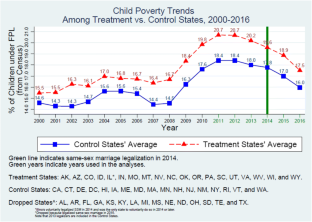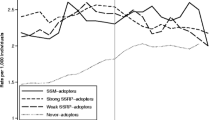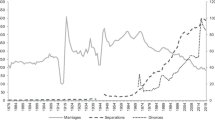Abstract
Introduction
Previous research examines the effects of same-sex marriage on many child and family outcomes, but only a small subset examines the effects of laws on those outcomes. We evaluate the effects of same-sex marriage legalization in the USA on four socio-familial outcomes.
Methods
We use currently available public data from the U.S. Census and CDC to analyze changes in state-level legalization of same-sex marriage on rates of child poverty, divorce, marriage, and children living in single-parent households within each state from 2011 to 2016. The estimators use traditional cross-sectional time-series methodologies, along with adjusting for high-dimensional fixed-effects (HDFE) clustering to account for both spatial and temporal dependence of state-time observations.
Results
We find no evidence to validate claims of negative ramifications from same-sex marriage legalization on these outcomes.
Discussion
With respect to the arguments articulated in Supreme Court amici briefs, we show that assertions of negative social effects of legalized same-sex marriage are largely unsupported.
Conclusion
In addition to illustrating the gains from HDFE estimators, we conclude that warnings of likely negative effects from same-sex marriage, such as disallowing adoption by same-sex couples, are not credible.




Similar content being viewed by others
Notes
There are extensive discussions that critique (e.g., Marks, 2012) and defend the validity (e.g., Amato, 2012) of these studies. One major study that found negative impacts of same-sex parents on child outcomes (Regnerus, 2012) was criticized when a replication did not come to the same conclusion (Cheng & Powell, 2015)
Louisiana, Utah, Texas, Alaska, Arizona, Arkansas, Georgia, Idaho, Kansas, Montana, Nebraska, North Dakota, Oklahoma, South Dakota, and West Virginia (listed here in same order as listed on the legal brief).
In economics, non-price entry barriers (such as refusing to hire based on race or gender) are inefficient: they impose costs not only on the excluded group but also on consumers or employers, while conferring smaller benefits (higher wages) on the privileged group. There are no social benefits.
Considerable research shows that marriage in general benefits both the two parents and the children, partly due to scale economies along with more income. In addition to within family benefits, external benefits of marriage include reduced demand for many social services (e.g, welfare and other income supports; police) that might otherwise be required if there were more single-parent families. See Ribar (2015); Sawhill and Thomas (2005); Thomas and Sawhill (2002); Sawhill and Haskins (2016); McLanahan and Sawhill (2015); Zissimopoulos, Karney, and Rauer (2015).
The early adopter control states include the 2013 legalizers (CA, DE, HI, MD, MN, NJ, NM and RI) and the earliest adopters (MA, 2004; CT, 2008; IO, V, 2009; NH, DC, 2010; NY, 2011; ME, WA, 2012). The treated states, forced to adopt by Windsor (except IL, which voluntarily adopted after Windsor) include OR, ID, MT, WY, NV, UT, AZ, CO, OK, WI, IL, IN, PA, WV, VA, NC, and SC. Omitted states (the late legalizers, forced to legalize by Roe in 2015) include ND, SD, NE, KS, TX, MO, AR, LA, MI, OH, KY, TN, MS, AL, GA, FL)
However, as a robustness check, we also provide a secondary model specification that drops all states from our “control” group which did not have same-sex marriage for multiple years prior to 2014. The results in Tables 1, 2, 3, and 4 do not change.
Note that Illinois was the only state post-Windsor to voluntarily legalize same-sex marriage.
For ease of interpretation, we use state-year levels in the dependent variables. However, because we use state fixed effects, the focal coefficient B represents the average within state difference in the dependent variable between treatment and control state (Ludwig & Cook, 2000); it is not a between state difference. As a robustness check, when we use difference-in-difference estimates of the relation between state-year changes in the policy adoption variable to state-year changes in dependent variables, along with the control variables and state fixed effects, the results do not change appreciably.
The SUR estimates show that the residuals are correlated:
Correlation matrix of residuals:
childpov divorce marriage sglpar
childpov 1.0000
divorce 0.0259 1.0000
marriage − 0.1606 0.5399 1.0000
sglpar 0.3548 0.0124 0.0768 1.0000
Breusch-Pagan test of independence: chi2(6) = 246.067, Pr = 0.0000.
We also estimated an xtreg with state-level fixed effects (Cameron & Trivedi, 2009; Wooldridge, 2010). Similar to Ludwig and Cook’s (2000) assessment of the Brady bill, we also performed a specification of ordinary least squares analysis with controls, heteroskedasticity-robust standard errors, and state and year fixed effect regressors. We do not show the results, but they do not differ from the results that we present.
Excluding 2013 legalizing states is a robustness check to provide a model where all the “control” states had same-sex marriage legalization for more than just 1 year. The results do not change.
These findings are robust to replacing rates in the dependent variables with log of rates. Neither the statistical nor substantive results changed. Data available upon request.
Opponents prefigured adverse effects of legalized same-sex marriage; therefore, we used directionally one-sided tests.
References
Adams, J., & Light, R. (2015). Scientific consensus, the law, and same sex parenting outcomes. Social Science Research, 53, 300–310.
Alabama (2015) http://sblog.s3.amazonaws.com/wp-content/uploads/2015/04/14-556_State_of_Alabama.pdf.
Allen, D. W. (2006). An economic assessment of same-sex marriage laws. Harvard Journal of Law and Public Policy, 29(3), 949–980.
Allen, D. W. (2010). Who should be allowed into the marriage franchise? Drake Law Review, 58, 1043–1079.
Allen, D. W. (2013). High school graduation rates among children of same-sex households. Review of Economics of the Household, 11, 635–658.
Allen, D. W., & Price, J. (2015). Same-sex marriage and negative externalities: A critique, replication, and correction of Langbein and Yost. Econ Journal Watch, 12(2), 142–160.
Amato, P. (2012). The well-being of children with gay and lesbian parents. Social Science Research, 41(4), 771–774.
American College of Pediatricians, Family Watch International, Marks, L. D., Regnerus, M. D., Sullins, D. P. (2015). Amici curiae brief supporting respondents, Obergefell v. Hodges, 135 S. Ct. 2584.
Anderson, R. (2013). Marriage: What it is, why it matters, and the consequences of redefining it. Washington DC: The Heritage Foundation.
Badgett, M., Nezhad, S., Waaldijk, C., & van der Meulen, R. (2014). The 962 relationship between LGBT inclusion and economic development: 963 An analysis of emerging economies. Washington DC: US Agency 964 for International Development & The Williams Institute.
Biblarz, T., & Stacey, J. (2010). How does the gender of parents matter? Journal of Marriage and Family, 72(1), 3–22.
Cameron, A. C., Gelbach, J. B., & Miller, D. L. (2011). Robust inference with multiway clustering. Journal of Business & Economic Statistics, 29(2), 238–249.
Cameron, A. C., & Trivedi, P. K. (2009). Microeconometrics using stata. College Station: STATA Press.
Cameron, A. C., & Trivedi, P. K. (2010). Microeconomics using Stata. College Station, TX: Stata Press.
Casper, L. M., McLanahan, S. S., & Garfinkel, I. (1994). The gender-poverty gap: What we can learn from other countries. American Sociological Review, 59(4), 594–605.
Cere, D., & Farrow, D. (2004). Divorcing marriage: Unveiling the dangers in Canada’s new social experiment. Montreal, Ontario: The Institute for the Study of Marriage, Law and Culture.
Chen, W. H., & Corak, M. (2008). Child poverty and changes in child poverty. Demography, 45(3), 537–553.
Cheng, S., & Powell, B. (2015). Measurement, methods, and divergent patterns: Reassessing the effects of same-sex parents. Social Science Research, 52, 615–626.
Cherlin, A. J. (2004). The deinstitutionalization of American marriage. Journal of Marriage and Family, 66(4), 848–861.
Cherlin, A. J. (2009). The marriage go-round. New York, NY: Alfred A. Knopf.
Chinni, D. (2004). Is the post-election red tinge a mandate? Don’t bet on it. Christian Science Monitor. https://www.csmonitor.com/2004/1104/p09s01-codc.html.
Cohen, L. R., & Wright, J. D. (2011). Research handbook on the economics of family law. Northampton, MA: Edward Elgar.
Correia, S. (2017a). REGHDFE: Stata module for linear and instrumental-variable/GMM regression absorbing multiple levels of fixed effects. Boston, MA: Statistical software components, Boston College Department of Economics. https://ideas.repec.org/c/boc/bocode/ s457874.html.
Correia, S. (2017b). A feasible estimator for linear models with multi-way fixed effects. (working paper). http://scorreia.com/research/hdfe.pdf.
Dao, J. (2004, November). 4. New York Times: Same-sex marriage issue key to some GOP races https://www.nytimes.com/2004/11/04/politics/campaign/samesex-marriage-issue-key-to-some-gop-races.html.
Dillender, M. (2014). The death of marriage? The effects of new forms of legal recognition on marriage rates in the United States. Demography, 51, 563–585.
Dinno, A. (2014). Comment on “The effect of same-sex marriage laws on different-sex marriage: Evidence from the Netherlands.”. Demography, 51, 2343–2347.
Ellis, B. J., Bates, J. E., Dodge, K. A., Fergusson, D. M., Horwood, L. J., Pettit, G. S., & Woodward, L. (2003). Does father absence place daughters at special risk for early sexual activity and teenage pregnancy? Child Development, 74(3), 801–821.
Family Equality Council. (2018). Joint Adoption Law. https://www.familyequality.org/get_informed /resources/equality_maps/joint_adoption_laws/.
Family Research Council. (2015). Amicus curiae brief supporting respondents and affirmance, Obergefell v. Hodges, 135 S. Ct. 2584.
Felter, C., & Renwick, D. (2019). Same-sex marriage: Global comparisons. Council on Foreign Relations. https://www.cfr.org/backgrounder/same-sex-marriage-global-comparisons.
Flouri, E. (2007). Fathering and adolescents’ psychological adjustment: The role of fathers’ involvement, residence and biology status. Child: Care, Health and Development, 34(2), 152–161.
Flouri, E., & Buchanan, A. (2003). The role of father involvement in children’s later mental health. Journal of Adolescence, 26, 63–78.
Frank, N., Weeden, K., & Baker, K. (2018). What does the scholarly research say about the well-being of children with gay or lesbian parents? Ithaca, NY: Center for Study of Inequality. https://whatweknow.inequality.cornell.edu/topics/lgbt-equality/what-does-the-scholarly-research-say-about-the-wellbeing-of-children-with-gay-or-lesbian-parents/.
Gallup (2019). Support for gay marriage stable. https://news.gallup.com/ poll/257705/suupport-gay-marriage-stable.aspx.?version=print.
Giddens, A. (1992). The transformation of intimacy: Sexuality, love, and eroticism in modern societies. Stanford, CA: Stanford University Press.
Goings, R. B., & Ford, D. Y. (2017). Investigating the intersection of poverty and race in gifted education journals: A 15-year analysis. Gifted Child Quarterly, 62(1), 25–36.
Goodfriend, M. (1992). Information-aggregation bias. The American Economic Review, 82(3), 508–519.
Harper, C. C., & McLanahan, S. S. (2004). Father absence and youth incarceration. Journal of Research on Adolescence, 14(3), 369–397.
Hawkins, A. J., & Carroll, J. S. (2015). Beyond the expansion framework: How same-sex marriage changes the institutional meaning of marriage and heterosexual men’s conception of marriage. Ave Maria Law Review, 13(2), 219–235.
Herek, G. (2006). Legal recognition of same-sex relationships in the United States: A social science perspective. American Psychologist, 61(6), 607–621.
Langbein, L., & Lichtman, A. (1976). Across the great divide: Inferring individual level behavior from aggregate data. Political Methodology, 3(4), 411–439.
Langbein, L., & Yost Jr., M. A. (2009). Same-sex marriage and negative externalities. Social Science Quarterly, 90(2), 292–308.
Lerman, R. I. (1996). The impact of the changing U.S. family structure on child poverty and income inequality. Economica, 63(250), S119–S139.
Lewis, G. B. (2005). Same-sex marriage and the 2004 presidential election. PS: Political Science and Politics, 38(2), 195–199.
Lichter, D. T., & Crowley, M. L. (2004). Welfare reform and child poverty: Effects of maternal employment, marriage, and cohabitation. Social Science Research, 33(3), 385–408.
Louisiana, Utah, Texas, Alaska, Arizona, Arkansas, Georgia, Idaho, Kansas, Montana, Nebraska, North Dakota, Oklahoma, South Dakota, and West Virginia. (2015). Amici curiae brief supporting respondents, Obergefell v. Hodges, 135 S. Ct. 2584.
Ludwig, J., & Cook, P. J. (2000). Homicide and suicide rates associated with implementation of the Brady handgun violence prevention act. Journal of the American Medical Association, 284(5), 585–591.
Manning, W. D., Feltro, M. N., & Lamidi, E. (2014). Child well-being in same-sex parent families: Review of research prepared for American Sociological Association amicus brief. Population Research & Policy Review, 33(4), 485–502.
Manning, W. D., & Lamb, K. A. (2003). Adolescent well-being in cohabiting, married, and single-parent families. Journal of Marriage and Family, 65, 876–893.
Marks, L. (2012). Same-sex parenting and children’s outcomes: A closer examination of the American Psychological Association’s brief on lesbian and gay parenting. Social Science Research, 41(4), 735–751.
Marquardt, E. (2006). Between two worlds: The inner lives of children of divorce. New York, NY: Three Rivers Press.
Marquardt, E. (2010). The kids are not all right. Human Life Review, 36(3), 113–115.
Marquardt, E., Glenn, N. D., & Clark, K. (2010). My daddy’s name is donor: A new study of young adults conceived through sperm donation. New York, NY: Institute for American Values. http://americanvalues.org/catalog/pdfs/Donor_FINAL.pdf
Masci, D., & DeSilver, D. (2019). A global snapshot of same-sex marriage. Pew Research Center. https://www.pewresearch.org/fact-tank/2019/06/21/global-snapshot-same-sex-marriage/.
Masci, D., Sciupac, E., & Lipka, M. (2019). Gay marriage around the world. Pew Research Center: Religion and Public Life. https://www.pewforum.org/fact-sheet/gay-marriage-around-the-world/.
McLanahan, S., & Sawhill, I. (2015). Marriage and child wellbeing revisited: Introducing the issue. The Future of Children, 25(2), 3–9.
Meezan, W., & Rauch, J. (2005). Gay marriage, same-sex parenting, and America's children. The Future of Children, 15(2), 97–115.
Members of the Kentucky General Assembly. (2015). Amici curiae brief supporting respondents, Obergefell v. Hodges, 135 S. Ct. 2584.
Murray, C. (2013). Coming apart: The state of white America, 1960–2010. New York, NY: Crown Forum.
Obergefell v. Hodges, 576 (US Supreme Court, 2015). https://www.supremecourt.gov/opinions/14pdf/14-556_3204.pdf.
Otter, C. L. (2015). Amici curiae brief, Obergefell v. Hodges, 135 S. Ct. 2584.
Posner, R. A. (1973). Economic analysis of law. New York, NY: Little, Brown and Co..
Potter, D. (2012). Same-sex parent families and children’s academic achievement. Journal of Marriage and Family, 74, 556–571.
Public Religion Research Institute. (n.d.) The American Values Atlas. http://ava.prri.org/home#lgbt/2017/states/lgbt_ssm.
Pujol, J. (2016). The United States safe space campus controversy and the paradox of freedom of speech. Church, Communication and Culture, 1(1), 240–254.
Regnerus, M. (2012). How different are the adult children of parents who have same-sex relationships? Findings from the new family structures study. Social Science Research, 41(4), 752–770.
Republican National Convention Committee. (2015). Amicus curiae brief supporting respondents, Obergefell v. Hodges, 135 S. Ct. 2584.
Ribar, D. (2015). Why marriage matters for child wellbeing. The Future of Children, 25(2), 11–27.
Riggle, E., Rostosky, S., & Horne, S. (2010). Psychological distress, well-being, and legal recognition in same-sex couple relationships. Journal of Family Psychology, 24(1), 82–86.
Romaniuc, R. (2016). What makes law change behavior? An experimental study. Review of Law & Economics, 12(2), 447–475.
Sawhill, I., & Haskins, R. (2016). The decline of the American family: Can anything be done to stop the damage? The Annals of the American Academy of Political and Social Science, 667(1), 8–34.
Sawhill, I., & Thomas, A. (2005). For love and money? The impact of family structure on family income. The Future of Children, 15(2), 57–74.
Scholars. (2015). Amici curiae brief supporting respondents and affirmance, Obergefell v. Hodges, 135 S. Ct. 2584.
Scholars of Marriage. (2015). Amici curiae brief supporting respondents, Obergefell v. Hodges, 135 S. Ct. 2584.
Texas Values. (2015). Amicus curiae supporting respondents, Obergefell v. Hodges, 135 S. Ct. 2584.
Thomas, A., & Sawhill, I. (2002). For richer or for poorer: Marriage as an anti-poverty strategy. Journal for Policy Analysis and Management, 21(4), 587–599.
Trandafir, M. (2014a). The effect of same-sex marriage laws on different-sex marriage: Evidence from the Netherlands. Demography, 51, 317–340.
Trandafir, M. (2014b). Reply to comment on “The Effect of Same-Sex Marriage Laws on Different-Sex Marriage: Evidence from the Netherlands”. Demography, 51, 2349–2350.
Trandafir, M. (2015). Legal recognition of same-sex couples and family formation. Demography, 52, 113–151.
United States v. Windsor, 570 US 744 (2013).
Voss, P. R., Long, D. D., Hammer, R. B., & Friedman, S. (2006). County child poverty rates in the US: A spatial regression approach. Population Research and Policy Review, 25(4), 369–391.
Wardle, L. D. (2001). Multiply and replenish: Considering same-sex marriage in light of state interests in marital procreation. Harvard Journal of Law and Public Policy, 24(3), 771–814.
Wardle, L. D. (2007). The fall of marital family stability and the rise of juvenile delinquency. Journal of Law & Family Studies, 10(2), 83–110.
Wax, A. L. (2007). Engines of inequality: Class, race, and family structure. Family Law Quarterly, 41(3), 567–599.
Wax, A. L. (2009). Review: The family law doctrine of equivalence. Michigan Law Review, 107(6), 999–1017.
Wooldridge, J. M. (2010). Econometric analysis of cross-section and panel data. Boston, MA: MIT Press.
Yancey, G. (2011). Compromising scholarship: Religious and political bias in American higher education. Waco, TX: Baylor University Press.
Young, K. K., & Nathanson, P. (2007). Redefining marriage or deconstructing society: A Canadian case study. Journal of Family Studies, 13, 133–178.
Zissimopoulos, J. M., Karney, B. R., & Rauer, A. J. (2015). Marriage and economic well-being at older ages. Review of the Economics of the Household, 13, 1–35.
Author information
Authors and Affiliations
Corresponding author
Ethics declarations
Conflict of Interest
The authors have no relevant financial or non-financial interests to disclose. The authors have no conflicts of interest to declare that are relevant to the content of this article. All authors certify that they have no affiliations with or involvement in any organization or entity with any financial interest or non-financial interest in the subject matter or materials discussed in this manuscript. The authors have no financial or proprietary interests in any material discussed in this article.
Research Involving Human Data
This is an observational study that uses publicly available aggregate data on humans. Specifically, as noted in the abstract of the manuscript, “we use currently available public data from the U.S. Census and CDC to analyze changes in state-level legalization of same-sex marriage on rates of child poverty, divorce, marriage, and children living in single-parent households within each state from 2011 to 2016.”
Additional information
Publisher’s Note
Springer Nature remains neutral with regard to jurisdictional claims in published maps and institutional affiliations.
Rights and permissions
About this article
Cite this article
Langbein, L., Ranallo-Benavidez, B. & Palmer, J.E. The Anti-Social Effects of Legalizing Same-Sex Marriage: Fact or Fiction?. Sex Res Soc Policy 18, 1060–1077 (2021). https://doi.org/10.1007/s13178-020-00509-y
Accepted:
Published:
Issue Date:
DOI: https://doi.org/10.1007/s13178-020-00509-y




